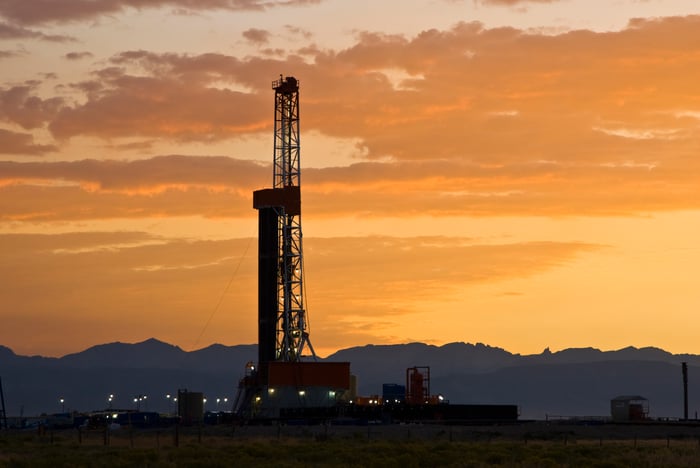While Devon Energy's (NYSE:DVN) drilling machine hit a bit of a speed bump during the third quarter due to some maintenance issues, the company didn't expect those problems to continue during 2018's final period. That's one of a few things investors should review when the company reports its fourth-quarter results this week.
1. See if production hits the targetDevon Energy's production came in toward the low end of its guidance range during the third quarter because of maintenance issues at its Jackfish oil sands facility in Canada. Consequently, output at that complex only averaged 104,000 barrels of oil equivalent per day (BOE/D) during the period. The company noted that it expected to resume full production in Canada during the fourth quarter, which would boost output in the country to between 115,000 to 120,000 BOE/D, putting it on track to produce between 515,000 to 543,000 BOE/D overall.

Image source: Getty Images.
The number to watch for the quarter, however, is Devon's U.S. oil production. The company sees it coming in between 127,000 to 131,000 barrels per day (BPD), which at the midpoint would put its full-year average at 123,000 BPD. That would enable the oil producer to achieve its forecast of growing its U.S. oil production 17% from 2017's level, which is higher than its initial expectation that output would rise 15% in 2018. Given that optimistic forecast, investors should see if U.S. oil production hit its target. If not, investors should check out what issues it ran into this time to cause its output to come in below expectations once again.
2. Look if there are any changes to its 2019 planDevon Energy provided investors with a preview of its 2019 plans during the third quarter. At that time, the company estimated that it would spend between $2.4 billion to $2.7 billion in drilling new wells, which is a bit higher than 2018's projected level. That additional spending would enable it to grow the oil production from its retained assets in the U.S. by 15% to 19% versus 2018's average.
However, oil prices have declined significantly since the company previewed its 2019 plans. That plunge caused several rivals to cut their spending in 2019. WPX Energy (NYSE:WPX), for example, initially expected to invest between $1.45 billion and $1.65 billion in 2019, which was an increase from its $1.3 billion to $1.4 billion range for 2018. WPX Energy has since slashed its budget range down to $1.1 billion-$1.275 billion in response to the decline in oil prices, which have gone from above $70 a barrel in early October to the low $50s in recent weeks.
Pioneer Natural Resources (NYSE:PXD) and Occidental Petroleum (NYSE:OXY) are also reducing spending in 2019. In the case of Pioneer Natural Resources, it's budgeting $2.8 billion to $3.1 billion in capital for the coming year, which is below 2018's level of $3.64 billion. Occidental Petroleum, meanwhile, is cutting its budget by 10% for 2019. Those spending cuts will enable both Pioneer and Occidental to generate free cash flow at the current oil price point, giving them both more money to return to investors.
Given all the spending cuts around the industry, it wouldn't be a surprise to see Devon take a more conservative approach in 2019. At a minimum, the company will likely aim to keep its budget flat with 2018's level, though a reduction would enable the driller to generate more free cash, which it could use to continue repurchasing stock.

Image source: Getty Images.
3. Is there an update to its capital return plans?Devon Energy is in the midst of an industry-leading share buyback program, with it on track to retire 20% of its outstanding shares by the end of this year's first quarter. The company had repurchased $2.7 billion in stock as of the end of the third quarter, leaving it with $1.3 billion remaining.
However, with that buyback winding down, investors should see if the company updates its capital return plans for 2019 above its current dividend, which it increased 33% last year. Devon did have $3.1 billion in cash on hand at the end of September, which along with the excess cash it could generate by keeping a lid on capital spending, would free the company up to return even more money to investors in 2019.
All eyes on 2019Devon Energy expected to get its drilling machine back on track during the fourth quarter, which is certainly something investors should watch when it reports those results. However, what's even more important is to see what the company plans to do in 2019. Ideally, it will join its peers and keep spending at or below the low end of its initial budget since that would free up even more cash to return to investors in 2019.
No comments:
Post a Comment